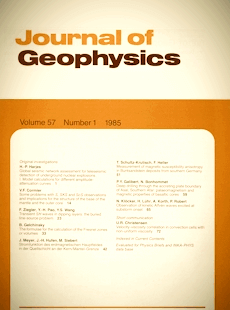The formulae for the calculation of the Fresnel zones or volumes
Article Sidebar

Vols. 1-18 (1924-1944), ISSN 0044-2801
Main Article Content
Abstract
The symmetrized invariant formulae for the calculation of Fresnel zones or volumes are derived. It is assumed that an inhomogeneous medium with curvilinear interfaces is located between the source and/or the receiver and along the central ray within the Fresnel zone or volume. In the vicinity of the zone centre, the medium is considered locally homogeneous. The formula for the leading term of the field of a wave scattered by a bent body immersed in the above-mentioned medium is obtained by the Kirchhoff approximation. With the help of this formula and the expressions for the Fresnel radii for a particular case, the formulae for the Fresnel zones in the general case considered are obtained on the basis of the reciprocity relation. The formulae for the Fresnel zones are used to obtain the expressions for the Fresnel volumes. The physical consequences of the derived formulae with respect to the validity of the ray formulae and the resolution of seismic methods etc. are discussed.
 ARK: https://n2t.net/ark:/88439/y093067
ARK: https://n2t.net/ark:/88439/y093067
Permalink: https://geophysicsjournal.com/article/292
Article Details
References
Alekseev, A.S., Gelchinsky, B. (1959) On the ray method of computation of a wave field for inhomogeneous media with curved interfaces. In: Problems in the dynamic theory of seismic wave propagation 3, 102-160, Leningrad University Press (In Russian)
Al'pert, Yal, Ginzburg, V.L., Fainberg, E.H. (1953) Radio wave propagation. Moscow Fizmatgiz (In Russian)
Bertonei, H.L., Felsen, L.B., Hessel, A. (1971) Local properties of radiation in lossy media. IEEE Trans. AP-19, N-3:226-238
Bleistein, N., Handlesman, R. (1975) Asymptotic expansions of integrals. Holt, Rinehard and Wiston - New York
Born, M., Wolf, E. (1980) Principles of optics. Pergamon Press, Oxford
Borovikov, V.A., Kinber, E.E. (1978) Geometrical theory of diffraction. Moscow Svjaz (In Russian)
Červeny, V., Ravindra, R. (1971) Theory of seismic head waves. University of Toronto Press
Deschamps, G.H. (1972) Ray techniques in electromagnetics. Proceedings of the IEEE, 60:1022-1035
Felsen, L.B., Marcuvitz, N. (1973) Radiation and scattering of waves. Prentice-Hall, New Jersey
Flatte, S.M. (Ed.) (1979) Sound transmission through a fluctuating ocean. Cambridge University Press
Gelchinsky, B. (1958) Calculation of the spreading function of rays in layered homogeneous isotropic media. In: Petrashen, G.I. (Ed.) Materials of quantitative investigations of dynamics of seismic waves 3:295-305. Leningrad University Press (In Russian)
Gelchinsky, B. (1961) An expression for the spreading function. In: Petrashen, G.I. (Ed.) Problems in dynamic theory of seismic wave propagation 5:47-53. Leningrad University Press (In Russian)
Gelchinsky, B. (1982a) Scattering of waves by a quasi-thin body of arbitrary shape. Geophys. J. R. Astron. Soc. 71:425-453
Gelchinsky, B. (1982b) Formulae for field of wave scattered by an inhomogeneous body and regions essential for reflection and propagation. Technical Program of 52nd Annual Meeting of SEG, Dallas, pp. 173-174
Gelchinsky, B., Karaev, N. (1980) Theoretical and model investigation waves scattered by quasithin bodies of arbitrary shape. Ann. Geophys. 36:509-518
Hagedoorn, T.G. (1959) The process of seismic reflection interpretation. Geophys. Prospecting 2:85-127
Hilterman, F.T. (1970) Three-dimensional seismic modeling. Geophysics 35:1020-1037
Hubral, P. (1980) Wavefront curvatures in three-dimensional laterally inhomogeneous media with curved interfaces. Geophysics 45:905-913
Hubral, P., Krey, T.H. (1980) Interval velocities from seismic reflection time measurements. Society of Exploration Geophysicists, Tulsa
James, G.L. (1974) Geometrical theory of diffraction. Peter Peregrinus, Stevenage, England
Keller, J.B. (1957) Diffraction by an aperture. Appl. Phys. 28:426-445
Kleyn, A.H. (1983) Seismic reflection interpretation. Applied Science, New York
Kravtsov, Y.A., Orlov, Y.A. (1980) The geometrical optics of inhomogeneous media. Nauka Press, Moscow (In Russian)
Shah, P.M. (1973) Use of wavefront curvature to relate seismic data with subsurface parameters. Geophysics 38:812-825
Sheriff, R.E. (1980) Nomogram for Fresnel-zone calculation. Geophysics 45:968-972
Sheriff, R.E., Geldart, L.P. (1982) Exploration seismology, Vol. 1. Cambridge University Press
Tatarsky, V.I. (1967) Wave propagation in a turbulent atmosphere. Nauka Press, Moscow (In Russian) [Translated into English: The effects of the turbulent atmosphere on wave propagation. Israel Program for Scientific Translation, Jerusalem, 1971]
Vainstein, L.A. (1957) Electromagnetic waves. Moscow Sovetskoe Radio (In Russian)
Zahradnik, T.U. (1977) SH-waves in the vicinity of rectangular impenetrable wedge. Ann. Geophys. 33:201-207











